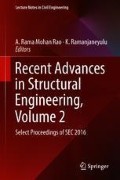Abstract
Most of the studies on the control of building frame using MR damper are investigated for far-field earthquake records, and a considerable reduction in responses is shown. However, MR dampers have some significant drawbacks like the saturation of MR dampers and its performance variability with respect to the ground motions. It has been found that when the predominant frequency of the earthquake is much away from the natural frequency of the structure, the response reduction becomes significantly less. The reason for this may be attributed to the less values of relative displacement and velocities of the floors which primarily influence the force generated in the damper for a given voltage. The characteristics of the near-field ground motion are distinctly different from the far-field ground motion. The performance of the MR damper for the near-field earthquake is not well investigated. In the present study, the performance of the MR dampers is studied for two types of near-field earthquakes, namely Bam (directivity effect) and Chichi (fling step effect) earthquakes. A limited number of MR dampers are employed for response reduction.
Access this chapter
Tax calculation will be finalised at checkout
Purchases are for personal use only
References
Jansen LM, Dyke SJ (2000) Semiactive control strategies for MR dampers: comparative study. J Eng Mech 126(8):795–803
Xu Y, Qu W, Ko J (2000) Seismic response control of frame structures using magnetorheological/electrorheological dampers. Earthq Eng Struct Dynam 29(5):557–575
Yoshida O, Dyke SJ (2004) Seismic control of a nonlinear benchmark building using smart dampers. J Eng Mech 130(4):386–392
Kori JG, Jangid R (2009) Semi-active MR dampers for seismic control of structures. Bull New Zealand Soc Earthq Eng 42(3):157
Christenson R et al (2008) Large-scale experimental verification of semiactive control through real-time hybrid simulation 1. J Struct Eng 134(4):522–534
Bahar A et al (2010) Hierarchical semi-active control of base-isolated structures using a new inverse model of magnetorheological dampers. Comput Struct 88(7):483–496
Chang C-C, Zhou L (2002) Neural network emulation of inverse dynamics for a magnetorheological damper. J Struct Eng 128(2):231–239
Lee H-J et al. (2005) Semi-active neuro-control strategy for a seismic-excited base isolated benchmark structure
Das D, Datta T, Madan A (2012) ANN-cum-fuzzy control of seismic response using MR dampers. In: Proceedings of the 15th World Conference on Earthquake Engineering (15 WCEE), Lisbon
Bharti S, Dumne S, Shrimali M (2014) Earthquake response of asymmetric building with MR damper. Earthq Eng Eng Vibr 13(2):305–316
Spencer B et al (1997) Phenomenological model for magnetorheological dampers. J Eng Mech 123(3):230–238
Dyke S et al (1996) Acceleration feedback control of MDOF structures. J Eng Mech 122(9):907–918
Author information
Authors and Affiliations
Corresponding author
Editor information
Editors and Affiliations
Rights and permissions
Copyright information
© 2019 Springer Nature Singapore Pte Ltd.
About this paper
Cite this paper
Bhaiya, V., Bharti, S.D., Shrimali, M.K., Datta, T.K. (2019). Performance of Semi-actively Controlled Building Frame Using MR Damper for Near-Field Earthquakes. In: Rao, A., Ramanjaneyulu, K. (eds) Recent Advances in Structural Engineering, Volume 2. Lecture Notes in Civil Engineering , vol 12. Springer, Singapore. https://doi.org/10.1007/978-981-13-0365-4_34
Download citation
DOI: https://doi.org/10.1007/978-981-13-0365-4_34
Published:
Publisher Name: Springer, Singapore
Print ISBN: 978-981-13-0364-7
Online ISBN: 978-981-13-0365-4
eBook Packages: EngineeringEngineering (R0)

